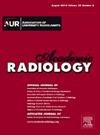Enhancing Radiologists’ Performance in Detecting Cerebral Aneurysms Using a Deep Learning Model: A Multicenter Study
IF 3.8
2区 医学
Q1 RADIOLOGY, NUCLEAR MEDICINE & MEDICAL IMAGING
引用次数: 0
Abstract
Rationale and Objectives
This study aimed to develop a deep learning (DL)-based model for detecting and diagnosing cerebral aneurysms in clinical settings, with and without human assistance.
Materials and Methods
The DL model was trained using data from 3829 patients across 11 clinical centers and tested on 484 patients from three institutions. Image interpretations were conducted by 10 radiologists (four junior, six senior), the DL model alone, and a combination of radiologists with the DL model. Time spent on post-processing and reading was recorded. The analysis of the area under the curve (AUC), sensitivity, and specificity for the above-mentioned three reading modes was performed at both the lesion and patient levels.
Results
Combining the DL model with radiologists reduced image interpretation time by 37.2% and post-processing time by 90.8%. With DL model assistance, the AUC increased from 0.842 to 0.881 (P = 0.008) for junior radiologists (JRs) and from 0.853 to 0.895 (P < 0.001) for senior radiologists (SRs). With DL model assistance, sensitivity significantly improved at both lesion (JR: 68.9% to 81.6%, P = 0.011; SR: 72.4% to 83.5%, P < 0.001) and patient levels (JR: 76.2% to 86.9%, P = 0.011; SR: 80.1% to 88.2%, P < 0.001). Specificity at the patient level showed improvement (JR: 82.6% to 82.7%, P = 0.005; SR: 82.6% to 86.1%, P = 0.021).
Conclusions
The DL model enhanced radiologists’ diagnostic performance in detecting cerebral aneurysms, especially for JRs, and expedited the workflow.
利用深度学习模型提高放射医师检测脑动脉瘤的能力:一项多中心研究。
原理与目标本研究旨在开发一种基于深度学习(DL)的模型,用于在临床环境中检测和诊断脑动脉瘤,无论是否有人工辅助:使用 11 个临床中心 3829 名患者的数据对深度学习模型进行了训练,并在三个机构的 484 名患者身上进行了测试。由 10 名放射科医生(4 名初级,6 名高级)、单独使用 DL 模型以及放射科医生与 DL 模型组合进行图像解读。后期处理和读片所花费的时间都被记录了下来。在病灶和患者层面对上述三种读片模式的曲线下面积(AUC)、灵敏度和特异性进行了分析:结果:将 DL 模型与放射科医生相结合,图像判读时间减少了 37.2%,后处理时间减少了 90.8%。在 DL 模型的帮助下,初级放射医师(JRs)的 AUC 从 0.842 提高到 0.881(P = 0.008),AUC 从 0.853 提高到 0.895(P 结论:DL 模型提高了放射医师的诊断能力:DL 模型提高了放射医师(尤其是初级放射医师)检测脑动脉瘤的诊断性能,并加快了工作流程。
本文章由计算机程序翻译,如有差异,请以英文原文为准。
求助全文
约1分钟内获得全文
求助全文
来源期刊

Academic Radiology
医学-核医学
CiteScore
7.60
自引率
10.40%
发文量
432
审稿时长
18 days
期刊介绍:
Academic Radiology publishes original reports of clinical and laboratory investigations in diagnostic imaging, the diagnostic use of radioactive isotopes, computed tomography, positron emission tomography, magnetic resonance imaging, ultrasound, digital subtraction angiography, image-guided interventions and related techniques. It also includes brief technical reports describing original observations, techniques, and instrumental developments; state-of-the-art reports on clinical issues, new technology and other topics of current medical importance; meta-analyses; scientific studies and opinions on radiologic education; and letters to the Editor.
 求助内容:
求助内容: 应助结果提醒方式:
应助结果提醒方式:


